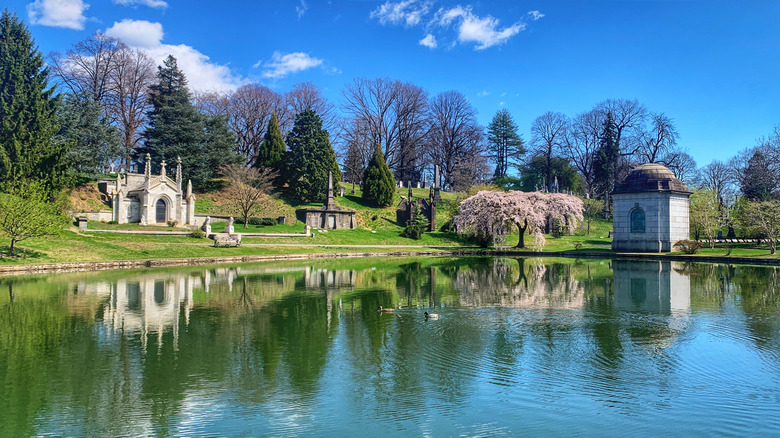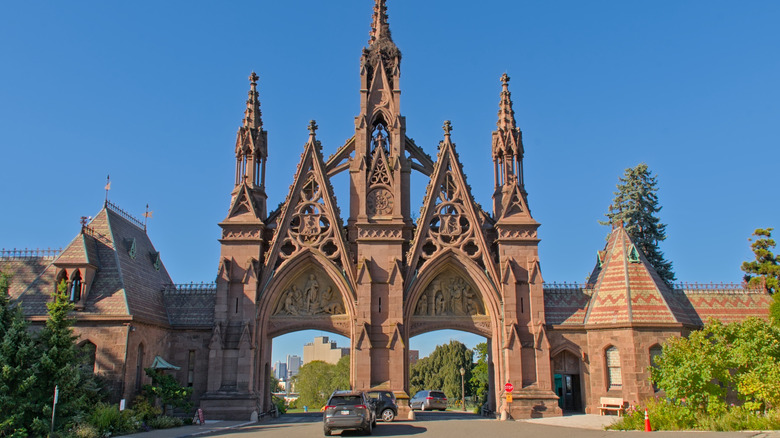A Historic Cemetery In Brooklyn Is An Open-Air Museum And Botanical Park With Statue Of Liberty Views
Cemeteries aren't always just for mourning. There are some that commemorate the dead by treating their resting place as a site of interest, dignified with artwork, gardens, or thoughtful design that invites reflection. Visiting cemeteries is one of the ways Rick Steves recommends getting a taste of Europe's macabre side, but the macabre element also comes with a sense of fascination and learning. Some cities have turned their cemeteries into beautifully landscaped parks to explore, like Chicago's historic Graceland Cemetery. In New York City, Green-Wood Cemetery also holds that prestige. It's simultaneously a National Historic Landmark with notable graves, an arboretum with rare trees, an open-air museum full of sculptures and monuments, and a nature walk with ponds, hills, and meandering paths that lead to incredible views.
When Green-Wood Cemetery was established in 1838, it was part of a trend of "rural cemeteries," where the dead could be buried in a deliberately idyllic setting while the living could relax and enjoy the scenery. Rural cemeteries like Green-Wood evoke peace and spiritual renewal, rather than the bleak, fatalistic tone of earlier cemeteries. That starting date, 1838, is also exactly 20 years before Central Park was built, and Green-Wood was a model for Central Park as well as other parks created afterwards. Green-Wood sprawls across 478 acres that encompass about 600,000 graves and over 7,000 trees — which is where the cemetery gets its name from. The cemetery's designer, David Bates Douglass, wanted to emphasize a sense of nature and serenity in Brooklyn that diverged from the angularity and fast pace of the city. The natural rolling landscape of Green-Wood was created by a glacier during the last ice age, which left behind ponds and hills, including the highest natural point in Brooklyn, from which you can see the Statue of Liberty.
A walk through Green-Wood Cemetery
Green-Wood Cemetery is in the western side of Brooklyn, adjacent to the beautifully wooded Prospect Park, another lovely escape. It's about 40 minutes away from Grand Central Terminal by subway, or a 30- to 40-minute drive from JFK International Airport. The main entrance is hard to miss, framed by a stunning Gothic Revival arch built in the 1860s. Look closely at the arch's spires, and you might see some of the green parakeets that have nested here. After passing through the arch, just to the right is a cluster of buildings including two chapels and the glass pavilion Tranquility Garden.
If you go left, you can follow Battle Avenue up a steep path to the top of Battle Hill — the park's highest point — where the Battle of Brooklyn took place in 1776. A statue of Minerva, the Greek goddess of war and victory, memorializes the battle, and if you follow her raised hand, you'll see that she's saluting straight out to a clear view of the Statue of Liberty. Just around the corner, on a smaller footpath, is the nondescript tombstone of composer Leonard Bernstein.
Look out for public art installations all over the cemetery, sometimes placed in unsuspecting spots like the cemetery's Catacombs or between gravestones. One installation by Sophie Calle titled "Here Lie the Secrets of the Visitors of Green-Wood Cemetery" can be found near the entrance and invites you to write a secret and bury it in the sculptural tomb. Sometimes you can catch interesting programming at the cemetery — it's hosted everything from pond-side circus performances to outdoor movie nights themed around death. These events may require a ticket purchase, but entry to the cemetery itself is always free, from 7 a.m. to 7 p.m. (hours may vary depending on the season).

